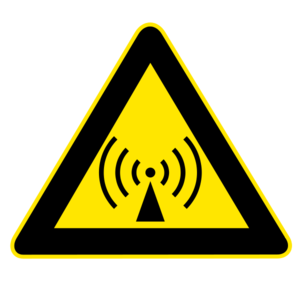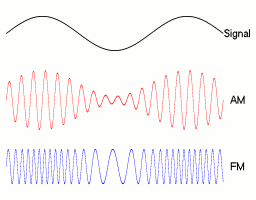Radio Waves
Radio Waves
When electrons move in a wire—that is, when there is an electric current in the wire—electric and magnetic fields are created around the wire. If the current is steady, then the electric and magnetic fields do not vary. But if the current varies, then the electric and magnetic fields vary. These variations in the electric and magnetic fields travel away from the wire, and because the electric-field variations and the magnetic-field variations are interrelated, the outward-traveling disturbances are called electromagnetic waves.
A wave is characterized by its wavelength—the distance from one crest to the next—and by its frequency—the number of crests per second. For any wave, the product of wavelength and frequency equals the speed of the wave. When electromagnetic waves have wavelengths in the range from 400 nanometers to 700 nanometers,(a nanometer is one billionth of a meter) they are visible to humans and are known as light. When electromagnetic waves have other wavelengths, they are known by other names, such as x-rays, ultraviolets rays, microwaves, and radio waves. Thus, the definition of light is given by human physiology, but the other divisions of the electromagnetic spectrum are more arbitrary. The full range of wavelengths is known as the electromagnetic spectrum.
Radio waves, by definition, have wavelengths from 1 millimeter to 1000 kilometers. As we mentioned above, the product of wavelength and frequency is the speed of the wave. But all electromagnetic waves move at the speed of light, which is 300,000 kilometers per second in a vacuum. So if we know the wavelength, we can calculate the frequency by dividing the speed of light by the wavelength. What all of this means is that the radio spectrum can be characterized by frequencies as well as by wavelengths. The radio spectrum may thus be given as 30 hertz (30 cycles per second) to 300 gigahertz (300,000,000,000 cycles per second). A 30 hertz wave has a wavelength of 10,000 kilometers, and a 300 gigahertz wave has a wavelength of 1 millimeter.
Radio waves may be used to carry information, such as speech or music because they vary in frequency. The radio waves we are most familiar with are those used in radio broadcasting and are divided into two types: amplitude modulation (AM) and frequency modulation (FM). AM stations use radio waves from 550 kilohertz to 1600 kilohertz, so the radio dial runs from 550 to 1600. FM stations use radio waves from 88 megahertz to 108 megahertz, so the dial runs from 88 to 108. Radio waves are used for many other purposes, like television broadcasting, radio navigation, and mobile communications.
This site is made possible by donations. If you find these articles valuable, please consider supporting the IEEE History Center’s work by making a donation to
IEEE Foundation - History Center Fund. There is a box marked “Designations” with an arrow which allows you to assign your gift to the History Center.

